(by Corbo Eng)
After hiding in the ground for the past 17 years, they’re back! No, not in DC proper and not in the close-in suburbs either (not yet anyway) but in and around Manassas about 30 miles from the city. There’s a smattering of cicadas in the woods along the Fairfax County/Prince William County line in Virginia—in the dense underbrush on terrain where Union and Confederate armies likely once clashed.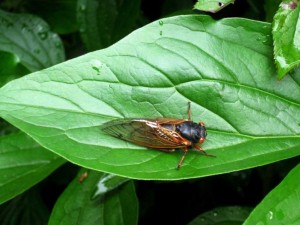
Right now, few cicadas are clinging to trees to create a canopy of insects, and none are overwhelming the nearby ground to lay out a living carpet as such; and, the mating call of the male cicadas, which typically sounds like a swarm of hovering spaceships, was more faint than pronounced. Instead, they are appearing modestly and offering modest signs of their presence—with individual cicadas and groups of two or three scattered sporadically about the waist-high foliage on the hilly shoreline above the rain swollen waters of Bull Run.
Along a meandering course, following a well-worn dirt path that locals have trampled out over time, it was easy pickings as the cicadas rested on leaves that provided a perfect platform for them to be plucked up by their wings. Offering no resistance and seemingly oblivious to impending danger, they, sometimes, would even grab onto my hand with their legs as if trying to jump from one leaf to another.
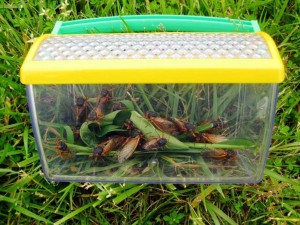 In fact, others in my troupe of cicada enthusiasts who suffered some initial hesitation and fear quickly got the hang of catching these docile critters (realizing that the cicadas’ dark appearance and haunting red eyes aren’t really a portent of attack). They don’t bite, are nearly blind, and are, at best, clumsy and reluctant flyers.
In fact, others in my troupe of cicada enthusiasts who suffered some initial hesitation and fear quickly got the hang of catching these docile critters (realizing that the cicadas’ dark appearance and haunting red eyes aren’t really a portent of attack). They don’t bite, are nearly blind, and are, at best, clumsy and reluctant flyers.
In the space of a half hour, the five of us (with our bare hands reaching and snatching at regular intervals) had captured roughly fifty cicadas in total (which we placed in three hand-held insect boxes that we had brought with us). As each transparent box filled with captured specimens (crawling and buzzing inside), we had gotten enough of them to satisfy ourselves. So, we made our way out of the woods onto the lawn of an adjoining playground, next to Bull Run, to debrief and marvel at our find.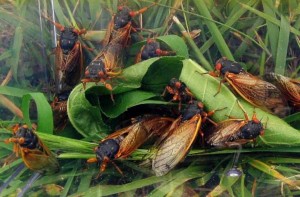
At this point, a few in our group wondered aloud what these things would taste like and began brainstorming recipes form a storehouse of chefly moves—as a grandmaster might move chess pieces in his head. It was all a little bit beyond me. But, the fact of the matter is cicadas are anthropods; that is, they have an exoskeleton and are relatives of other anthropods that regularly end up on our dinner table—shrimp, lobsters, and crabs. Supposedly, they can be prepared in much the same way as their seaborne counterparts.
However, as our conversation continued, I quickly discovered that cicadas can also be marinated, pickled, covered in chocolate, or even eaten unadorned, as it were, once de-winged and cleaned—to be popped in one’s mouth like almonds. In fact, that’s how I imagined eating them frankly. I had eaten Mexican grasshoppers, called chapulines, at an Oaxacan restaurant in L.A. where they were used to make tacos. Just lightly sautéed, the chapulines offered a distinctive crunch with each bite. I imagined that these cicadas, about the same size as those grasshoppers, would too. Really, it was the crunch that I was looking forward to most. That always seemed to be a large part of the appeal of eating insects. Who wants to eat soft, squishy, or indiscriminate bugs? No one, right? But, in fact, I’ve been eating them indiscriminately all along.
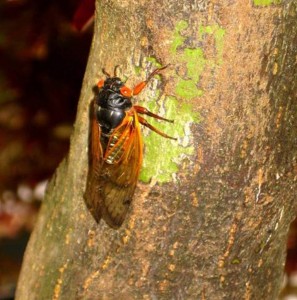 It seems that bugs are routinely consumed every day in mass produced foods—foods like peanut butter, jams, bread, and ketchup—where one variety or another of creepy crawly critters are ground into the final product as they are caught up in the assembly line production. The Food and Drug Administration knows about it and regulates it so that nothing ultimately defies a level safe for human consumption. But, the fact of the matter is that insects, quite frankly, are very healthy. They are high in protein, offer essential vitamins, are low in fat, have zero carbohydrates, and are gluten-free. In the roughly one to two pounds of insects that the average American eats every year, there are definite gains to be had.
It seems that bugs are routinely consumed every day in mass produced foods—foods like peanut butter, jams, bread, and ketchup—where one variety or another of creepy crawly critters are ground into the final product as they are caught up in the assembly line production. The Food and Drug Administration knows about it and regulates it so that nothing ultimately defies a level safe for human consumption. But, the fact of the matter is that insects, quite frankly, are very healthy. They are high in protein, offer essential vitamins, are low in fat, have zero carbohydrates, and are gluten-free. In the roughly one to two pounds of insects that the average American eats every year, there are definite gains to be had.
There wasn’t any doubt that the cicadas that we had captured would qualify as anything but a healthy indulgence. As the talk and discussion rose to a crescendo and the squeamish voices had seemingly been silenced, the consensus was that we would steam the cicadas rather than fry them (which would be unhealthy) and prepare them as if they were Maryland blue crabs—even with requisite Old Bay Seasoning to spice them up a bit. It was the anthropod connection taking center stage.
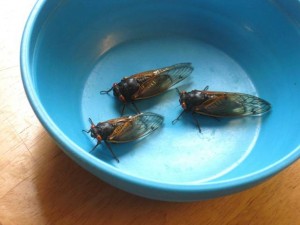 Once home, however, everyone was tired; and, all that talk of steaming the cicadas like blue crabs had died down. There was talk of ordering pizza or Chinese food; and, honestly, I didn’t care which option ultimately my companions chose. However, there would be no cicada feast. I recall looking into one of our transparent insect boxes and wondering when I would go hunting for them again—what had transpired in my own life in the past 17 years and what I would be doing 17 years from now. “How do you guys stay underground for so long and how do you know when to emerge?” I asked them. They didn’t answer. Anyway, it had been a long day; and, I was hungry. “How much shrimp fried rice should I order?” I heard someone cry out. I could only smile.
Once home, however, everyone was tired; and, all that talk of steaming the cicadas like blue crabs had died down. There was talk of ordering pizza or Chinese food; and, honestly, I didn’t care which option ultimately my companions chose. However, there would be no cicada feast. I recall looking into one of our transparent insect boxes and wondering when I would go hunting for them again—what had transpired in my own life in the past 17 years and what I would be doing 17 years from now. “How do you guys stay underground for so long and how do you know when to emerge?” I asked them. They didn’t answer. Anyway, it had been a long day; and, I was hungry. “How much shrimp fried rice should I order?” I heard someone cry out. I could only smile.
Copyright 2013 (Corbo Eng). All rights reserved.
All photos by Corbo Eng.
